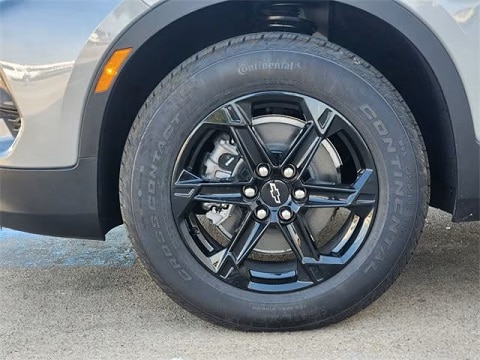
The right tires can make or break your driving experience. Your car's grip, handling, and safety all depend on your tires. At Huffines Chevrolet Plano, we've put together this guide to help you cut through the confusion about tire types. We'll help you find the best tire option for your vehicle and driving style — whether you're cruising on highways or tackling Texas back roads.
Understanding the Basics of Car Tires
Tires have various components that are important to your vehicle. The tread, or the outer pattern that comes into contact with the road, gives you grip. Beneath the tread are steel belts. These provide stability and puncture resistance while helping the tire maintain its shape under load. The sidewall offers support. The sidewall is also where you'll find vital information about the tire. Additionally, inner components such as casing plies, inner liners, and beads work together to keep you driving smoothly.
Those numbers and letters on your tire's sidewall tell you the width, aspect ratio, and rim diameter — information you'll need when shopping for replacements. The load index tells you how much weight each tire can safely carry. Speed ratings run from L (75 mph) up to Y (186 mph). They indicate the maximum sustained speed your tire can handle without failing.
The Importance of Tire Selection
Finding the right tire goes beyond just selecting one that fits. Your car type matters, too. For example, a family SUV needs different tires than a sporty coupe. Where you drive also factors into your tire selection. Are you driving on city streets? Highways? Occasional dirt roads? Each demands different tire characteristics. Quality tires can save you money on gas, improve car handling, and might even save you from an accident during emergency stops.
Types of Car Tires and Their Uses
The following are some of the most common tire options you may come across:
- All-season tires: These versatile tires can last up to 85,000 miles and offer decent grip in varied weather. However, they may struggle in heavy snow and Texas's summer heat.
- Summer tires: Designed for speeds up to 186 mph, these tires provide superior cornering on warm roads. They grip well on dry and wet surfaces but can become dangerous in cold weather, particularly if driven on snow or ice.
- Winter tires: Ideal for cold conditions, these tires have deep treads and flexible rubber that grip snow and ice. Switching to these tires is recommended when temperatures drop below 45 degrees.
- All-terrain tires: These tires combine comfort with off-road capabilities. They're popular with SUV owners who appreciate their ability to handle dirt roads without sacrificing ride quality.
- Mud-terrain tires: These tires feature large treads for serious off-roading but may generate more noise, be less efficient, and wear out more quickly.
- Performance tires: This type of tire provides precise handling for sports cars, but they wear out quickly and struggle in wet conditions.
- Touring tires: These tires prioritize comfort and durability and are ideal for family vehicles.
Specialty Tires for Unique Needs
Some driving situations require specialized tires. Low rolling resistance options improve fuel economy by reducing energy loss, making them ideal for hybrids and electric vehicles. Run-flat tires can continue functioning for up to 50 miles following a puncture, eliminating the need for dangerous roadside changes, although they often come at a higher cost and provide a firmer ride. Additionally, you can get digital tires that utilize sensors to report pressure, temperature, and wear to your vehicle's systems.
Other specialty tires include:
- Self-sealing tires that repair themselves after a puncture
- Heavy-duty truck tires
- Racing tires for track days
- Trailer tires for towing.
It's important to choose specialty tires based on their intended purpose, as they may not be suitable for daily driving.
Tire Maintenance and Care
Taking proper care of your tires is vital. We recommend checking your tire pressure monthly, as low pressure can decrease fuel efficiency and risk blowouts. Always follow the recommended pressure detailed in your owner's manual, not the maximum listed on the sidewall, for optimal safety and comfort.
It's also important to rotate your tires every 5,000-8,000 miles and make sure to address any alignment issues immediately if you notice vibrations in your steering or your car pulls to one side. You can check the tread using the penny test: if the top of Lincoln's head is fully visible, it's time to replace your tires. Also, inspect your tires regularly for unusual wear, cracks, or bulges, as catching issues early can prevent costly problems later on.
When To Replace Your Tires
It's essential to replace tires promptly for safety reasons. The legal minimum tread is 2/32 of an inch, but we recommend switching tires when the tread reaches 4/32 of an inch for better wet-weather grip. Tread wear indicators will signal when it's time for replacement. Don't ignore these signs, as driving on bald tires increases your risk of accidents, especially when it's wet.
The age of your tires matters, too. Rubber degrades over time, even if the tread is still good. We recommend replacing tires every six years but never exceed 10. You can check the age via the tire's four-digit DOT code. For example, 3619 means it was made in week 36 of 2019.
Finding the Right Tire for Your Vehicle
Choosing the right tires can make all the difference. Whether you're mostly running errands around town, commuting on Dallas highways, or heading out on weekend adventures, your tires should match your lifestyle. Don't overlook the Texas weather, either, as our scorching summers and freezing winters can impact your tire choice.
Still scratching your head about what's right for your vehicle? Contact us at Huffines Chevrolet Plano. Our tire experts can match you with options that fit your vehicle, driving style, and budget — keeping you and your family safe mile after mile.